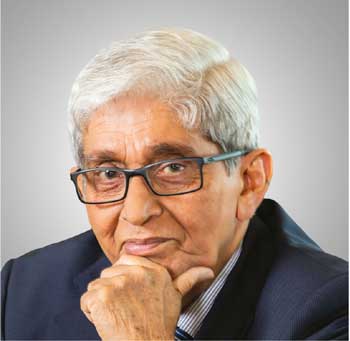EXTERNAL SECTOR
New Dimensions
Deshamanya Prof. W. D. Lakshman reviews the state of the external sector
The external sector of the economy is usually analysed using the quantifiable variables of exports, imports, the trade and current account deficits, exchange rate variations, the reserves position and foreign debt levels.
To complete this analysis, structural issues affecting the sector must be examined too. The COVID-19 crisis has added a significant community health dimension of yet unknown duration or potency to external sector issues.
Simultaneously, the coronavirus pandemic has become a blessing in disguise, providing policy makers deep insights into the structural problems of the external sector while creating a facilitating environment to introduce long delayed corrective actions.
Sri Lanka’s perennial problem of persistent trade and current account deficits in the balance of payments (BOP) largely has its origins in the country’s production base of domestic agricultural, industrial and service activities.
Inadequate capital accumulation and innovation have made domestic production relatively undiversified and sluggish in movin g forward. While undermining the country’s employment and income bases, this has also weakened the external sector.
g forward. While undermining the country’s employment and income bases, this has also weakened the external sector.
The capacity to produce exportable goods and services has remained limited, whereas expansion and diversification of consumer demand in the context of globalised development has led to a rapid increase in demand for a variety of imported goods and services.
Combined with unplanned trade liberalisation, this resulted in a continuous rise in trade and current account deficits, rendering the economy increasingly dependent on and burdened by foreign borrowings. COVID-19 related developments have highlighted the need to take corrective action to address these multifaceted problems in domestic and external accounts.
COVID-19 has produced a welcome change in policy thinking. Pragmatism and common sense are permitted to determine policy action, to maintain a reasonable balance in the trade and current accounts.
Exports are promoted through direct government intervention. No hesitation is shown to use quantitative controls where needed to dampen import expansion. Export growth has become strong relative to commodity imports.
The consequent narrowing of the trade deficit between April and October last year was a welcome change. Helped by these developments and changes in policy approaches, the external sector is moving towards greater balance and stability.
There are minor challenges to be addressed but they don’t appear formidable when alternative policy solutions are boldly implemented. Confidence levels of investor classes are gradually improving, pushing up rates of investment, production, employment and incomes. There will be corresponding improvements in the external sector as well.
While there was visible commodity-wise diversification of exports after 1977, Sri Lanka is now viewed as an exporter of manufactured goods that earns 66 percent of exports from three product categories: tea, garments and rubber products.
Furthermore, it has developed only a few overseas markets and the export destination country concentration remains high. The UK, the EU and the US account for 57 percent of Sri Lanka’s exports. As 75 percent of imports are Asian and from the Middle East, conscious planning and strategisation is needed to capture more of these markets for exports.
There is an enhanced policy interest in promoting exports of selected agricultural and industrial products, and services related to IT, business process outsourcing (BPO), and transport and logistics related services. While the COVID-19 pandemic has led to a virtual collapse of a major foreign exchange earner – viz. the tourism industry – with Sri Lankan Tourism depending almost entirely on overseas visitors, it has made hospitality and related activities shift gradually towards local guests.
This could be a welcome structural transformation in the industry, reducing its vulnerability to disruptive events such as this pandemic.
Workers’ remittances constituted another major source of foreign exchange for Sri Lanka. In more recent times, they remained around US$ 7 billion a year.
Some overseas workers are believed to have abandoned jobs and returned home or been laid off with compensation in the wake of the COVID-19 crisis.
Monthly remittances after June 2020 and in the three months running remained at approximately 700 million dollars. The increase in this number is partly due to special COVID-19 related short-term factors and cannot be taken as indicative of a trend; but it provides the required short-term relief to the BOP.
Imports for consumption have ex panded beyond affordable limits. With careful planning, some saving on imports of intermediate and investment goods, in addition to imported consumer goods, could be achieved.
panded beyond affordable limits. With careful planning, some saving on imports of intermediate and investment goods, in addition to imported consumer goods, could be achieved.
Apart from helping to manage the external account, a well planned import policy could become an essential part of stimulus policies for domestic production. Measures taken against the backdrop of COVID-19 to stringently plan imports into the country have been beneficial.
Due to these developments, the trade deficit narrowed by about US$ 1 billion between January and August 2020 compared to the corresponding period of the previous year.
The Central Bank of Sri Lanka (CBSL) maintains an adequate level of foreign reserves of approximately US$ 6 billion even after repayment of a billion dollar loan in 2020. Favourable developments in inflows helped CBSL purchase foreign exchange from the domestic market.
A foreign currency term financing facility from China Development Bank (CDB) and proceeds of the SAARC currency swap facility from the Reserve Bank of India (RBI) have also helped maintain reserve levels.
Additionally, CBSL has maintained exchange rate stability after a short spell of sharp depreciation between March and April 2020. Currency stability has in turn helped reduce the rupee value of foreign debt obligations.
An improved surplus in the services account is expected over the medium term – particularly with an expected tourism revival in 2021 and higher growth in emerging service sectors such as IT/BPO. When the COVID-19 threat comes under control globally, workers’ remittances too are likely to regain momentum. A declining current account deficit will improve the external sector outlook in the medium term.
The financial account of the BOP is set to improve over the medium term despite the pandemic induced setback of 2020. With the build-up of positive investor sentiment following the restoration of political stability, an expected recovery in global economies and normalising global financial market conditions, a gradual increase in foreign direct investment (FDI) and foreign portfolio investments is anticipated in the medium term.
Higher FDI inflows are expected on account of property and infrastructure development projects, and new programmes being earmarked by the government.
Deshamanya Prof. W. D. Lakshman is the Governor of the Central Bank of Sri Lanka.





